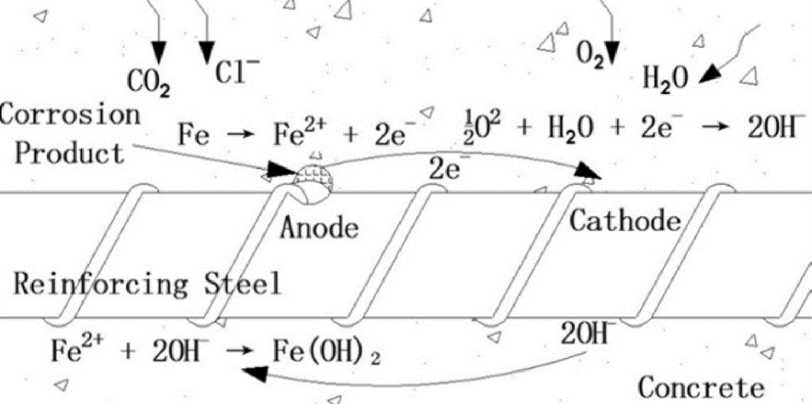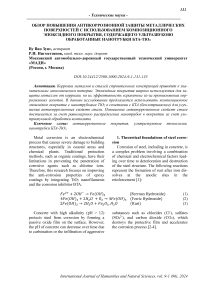Increasing the anti-corrosion protection of metal surfaces using a composite epoxy coating with BTA-TiO2 nanotubes treated with ultrasound: a review
Автор: Dung Vu.V., Nigmetzyanov R.I.
Журнал: Международный журнал гуманитарных и естественных наук @intjournal
Рубрика: Технические науки
Статья в выпуске: 9-1 (96), 2024 года.
Бесплатный доступ
Corrosion of metals and steels in building structures leads to significant economic losses. Epoxy coatings are widely used to protect metals from corrosion, but their effectiveness is limited due to the penetration of corrosive agents. This study proposes the use of a composite epoxy coating with TiO2 nanotubes in combination with BTA (benzotriazole) to improve the anti-corrosion properties of steel. An increase in the anti-corrosion properties of steel is achieved by uniform distribution of nanotubes in the coating due to ultrasonic treatment of the composite.
Corrosion protective coatings, ultrasonic technologies, bta-tio2 nanotubes
Короткий адрес: https://sciup.org/170207506
IDR: 170207506 | DOI: 10.24412/2500-1000-2024-9-1-131-135
Текст научной статьи Increasing the anti-corrosion protection of metal surfaces using a composite epoxy coating with BTA-TiO2 nanotubes treated with ultrasound: a review
Concrete with high alkalinity (pH > 12) protects steel from corrosion by forming a passive oxide film on the surface. However, the pH of concrete can decrease over time due to carbonation or the infiltration of aggressive покрытия, ультразвуковые технологии,
1. Theoretical foundations of steel corrosion
Corrosion of steel, including in concrete, is a complex problem involving a combination of chemical and electrochemical factors leading over time to deterioration and destruction of the steel structure. The following reactions represent the formation of rust after iron dissolves at the anodic sites in the reinforcement [1]:
(Ferrous Hydroxide) (1) 4Fe(0H')3 (Ferric Hydroxide) (2) .H20 (Rust) (3)
substances such as chlorides (Cl-), sulfates (SO 4 2-), and carbon dioxide (CO 2 ), which destroys the protective film and accelerates the corrosion process [2-4].

Fig. 1. Schematic illustration of reinforcing steel corrosion in concrete as an electrochemical process [5]
2. Problems of using protective epoxy coatings.
Although epoxy coatings are widely used to protect steel in concrete from corrosion, their effectiveness can be limited over time. The main reason is that epoxy coatings can peel or fail due to a variety of factors, including poor or incorrect construction techniques, mechanical stress, and temperature changes. When the coating is damaged, aggressive substances such as water, chloride ions and sulfates easily penetrate into the concrete and attack the steel, leading to corrosion [6-8]. In addition, epoxy coatings can become saturated with aggressive substances over time, especially in conditions of high humidity and temperature. Therefore, epoxy coatings for the protection of steel, including in concrete, must be used in combination with the use of high-strength concrete, corrosion-resistant reinforcement, and regular inspection and repair to ensure the longevity of the coating and the structure as a whole.
3. Features of BTA-TiO2 nanocompositions.
From an analysis of scientific works in this area, it follows that most studies are focused mainly on improving mechanical properties when using TiO 2 nanoparticles in epoxy coatings [9-11]. However, in recent years, some studies show that the presence of TiO 2 nanotubes in epoxy resin can not only improve the mechanical properties [12-13], but also improve the heat resistance and anticorrosion properties [14-16] compared to micron-sized particles. However, uniform distribution of TiO 2 nanotubes in the resin is an extremely difficult task.
One of the promising applications of TiO 2 nanotubes is their use as a nanocontainer for storing corrosion inhibitors, including Benzotriazole (BTA) [17]. BTA has wide applicability in various fields, including as an effective corrosion inhibitor of various metals and alloys (Fig. 2).

Fig. 2. Schematic representation of loading corrosion inhibitor into TiO 2 nanocontainers
As part of the study [18], TiO 2 nanoparticles were synthesized and loaded with the BTA inhibitor, which was then randomly distributed in a protective coating based on silane-titanium. The controlled release of corrosion inhibitors from TiO 2 nanoparticles was studied, and a higher release rate was observed at low pH. The integration of TiO 2 nanoparticles into a solgel coating has led to an increase in the effectiveness of corrosion protection of metal alloys. Loading BTA into nanocontainers, rather than directly introducing it into the solgel coating avoided interaction with the solgel network and improved the anti-corrosion properties of the coating.
-
4. Advantages of ultrasonic influence in the creation and application of composite materials.
-
5. Research and development of a composite material based on BTA-TiO 2 in an epoxy matrix.
At the stage of creating liquid composite materials, volumetric ultrasonic exposure makes it possible to increase the uniformity of filler distribution in the matrix. In the process of applying composite coatings to metal surfaces, the use of ultrasound can bring significant benefits.
First, ultrasound helps improve adhesion between the coating and the metal substrate. By creating high pressure, ultrasound stimulates the coating to penetrate cracks and hard-to-reach areas of the surface, providing a strong and durable connection. Secondly, ultrasound promotes uniform distribution of the coating over the entire surface. Mechanical waves created by ultrasound prevent voids and ensure uniform coverage [19-20].
This work examines the possibility of producing protective epoxy compositions containing BTA-TiO 2 nanotubes using ultrasound using the following technology:
-
1. Synthesis of TiO 2 nanowires by methods such as hydrothermal reaction, sol-gel and gas phase to achieve the desired size, shape and structure, optimization of factors such as temperature, reaction time, pH and ratio of starting materials;
-
2. Binding of BTA to TiO 2 nanowires through a chemical reaction or adsorption, the effectiveness of which depends on the type of binding agent, BTA concentration, pH and reaction time;
-
3. Production of epoxy compositions containing BTA-TiO 2 nanotubes by ultrasonic dispersion of TiO 2 /BTA nanotubes in epoxy resin.
Conclusion
The use of ultrasound in the technology of manufacturing and applying protective compositions with BTA-TiO 2 nanotubes promises significant prospects. This method allows not only to improve the adhesion of applied protective compositions to the metal substrate but also to evenly distribute BTA-TiO 2 nanotubes in the composition, improving the properties of the protective coating, including anti-corrosion properties. Further research and development in this area may lead to new products that are highly protective and environmentally friendly.
Список литературы Increasing the anti-corrosion protection of metal surfaces using a composite epoxy coating with BTA-TiO2 nanotubes treated with ultrasound: a review
- Klieger, Paul. "Durability studies at the Portland cement association." Durability of Building Materials and Components. ASTM International, 1980. [https://doi.org/10.1520/STP36066S].
- Groysman, Alec. "Corrosion monitoring." Corrosion Reviews 27.4-5 (2009): 205-343. [https://doi.org/10.1515/CORRREV.2009.27.4-5.205].
- Pedeferri, Pietro, and Marco Ormellese. Corrosion science and engineering. Vol. 720. Cham: Springer, 2018.
- Broomfield, John P. Corrosion of steel in concrete: understanding, investigation and repair. Crc Press, 2023. [https://doi.org/10.1201/9781003223016].
- Zhao, Xuefeng, et al. "Brillouin corrosion expansion sensors for steel reinforced concrete structures using a fiber optic coil winding method." Sensors 11.11 (2011): 10798-10819. [https://doi.org/10.3390/s111110798].
- Erdogdu, §., T. W. Bremner, and I. L. Kondratova. "Accelerated testing of plain and epoxy-coated reinforcement in simulated seawater and chloride solutions." Cement and Concrete Research 31.6 (2001): 861-867. [https://doi.org/10.1016/S0008-8846(01)00487-2].
- Pincheira, José A., et al. "Corrosion performance of epoxy-coated bars in four bridge decks subjected to deicing salts: 30-year perspective." Journal of Performance of Constructed Facilities 29.4 (2015): 04014097. [https://doi.org/10.1061/(ASCE)CF. 1943-5509.0000592].
- Wang, Xiao-Hui, and Li Zheng. "Durability and ultimate performance of concrete beams with epoxy-coated reinforcing bars." Proceedings of the Institution of Civil Engineers-Structures and Buildings 175.6 (2022): 437-452. [https://doi.org/10.1680/jstbu.19.00156]
- Samat, M. H., et al. "Hubbard U calculations on optical properties of 3d transition metal oxide TiO2." Results in physics 6 (2016): 891-896. [https://doi.org/10.1016/j.rinp.2016.11.006].
- O'regan, Brian, and Michael Grätzel. "A low-cost, high-efficiency solar cell based on dye-sensitized colloidal TiO2 films." Nature 353.6346 (1991): 737-740. [https://doi.org/10.1038/353737a0].
- Ou, Hsin-Hung, and Shang-Lien Lo. "Review of titania nanotubes synthesized via the hydrothermal treatment: Fabrication, modification, and application." Separation and purification Technology 58.1 (2007): 179-191. [https://doi.org/10.1016/j.seppur.2007.07.017].
- Seo, Hyung-Kee, et al. "A study on the structure/phase transformation of titanate nanotubes synthesized at various hydrothermal temperatures." Solar Energy Materials and Solar Cells 92.11 (2008): 1533-1539. [https://doi.org/10.1016/j.solmat.2008.06.019]
- Sreekantan, Srimala, and Lai Chin Wei. "Study on the formation and photocatalytic activity of titanate nanotubes synthesized via hydrothermal method." Journal of Alloys and Compounds 490.1-2 (2010): 436-442. [https://doi.org/10.1016/jjallcom.2009.10.030].
- Chatterjee, Amit, and Muhammad S. Islam. "Fabrication and characterization of TiO2-epoxy nanocomposite." Materials Science and Engineering: A 487.1-2 (2008): 574-585. [https://doi.org/10.1016/j.msea.2007.11.052].
- Kiatkittipong, Kunlanan, Jason Scott, and Rose Amal. "Hydrothermally synthesized titanate nanostructures: Impact of heat treatment on particle characteristics and photocatalytic properties." ACS applied materials & interfaces 3.10 (2011): 3988-3996. [https://doi.org/10.1021/am2008568]. '
- Sun, Kyung Chul, Muhammad Bilal Qadir, and Sung Hoon Jeong. "Hydrothermal synthesis of TiO2 nanotubes and their application as an over-layer for dye-sensitized solar cells." RSC advances 4.44 (2014): 23223-23230. [https://doi.org/10.1039/C4RA03266G].
- Walker, R. "Triazole, benzotriazole and naphthotriazole as corrosion inhibitors for copper." Corrosion 31.3 (1975): 97-100. [https://doi.org/10.5006/0010-9312-3L3.97].
- Arunchandran, C. "Self-Healing Coatings for Active Corrosion Protection: The Concept, Design, Evaluation and Challenges." A Treatise on Corrosion Science, Engineering and Technology. Singapore: Springer Nature Singapore, 2022. 663-694. [ISBN: 978-981-16-93014].
- Athanassiadis, Athanasios G., et al. "Ultrasound-responsive systems as components for smart materials." Chemical reviews 122.5 (2021): 5165-5208. [https://doi. org/10.1021/acs.chemrev.1c00622].
- Nigmetzyanov, Ravil I., et al. "Ultrasonic Preparation of Coating Surfaces." E3S Web of Conferences. Vol. 398. EDP Sciences, 2023. [https://doi.org/10.1051/e3sconf/202339801041].


